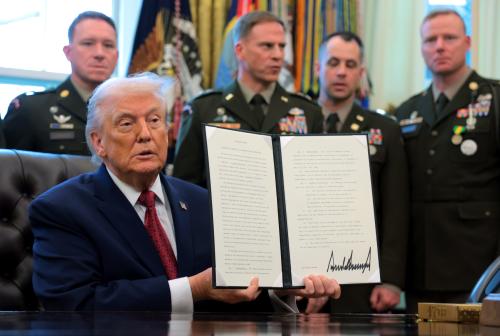Editor’s Note: As part of the 2014 Midterm Elections Series, we’ve asked experts from the ten states with competitive Senate races to answer six questions in a spotlight on each race, providing perspective on the dynamics in the state as we head toward Election Day. In this post, Patrick Miller examines the Kansas Senate race between Senator Pat Roberts and independent candidate Greg Orman.
1. What have been the three key issues in this year’s Senate race?
For a major Senate race, Kansas has been remarkably devoid of anything that one might call “real” substantive issues. Rather, the candidates themselves and their traits have been the centerpiece of the campaign.
The first major issue was Roberts himself. His poor personal brand is probably the only reason Kansas is on the national radar this year. In February 2013 a Public Policy Polling (PPP) survey showed that despite three Senate terms, 41% of Kansans had no opinion on Roberts’s job performance. His net approval was merely +3 (31% approve, 28% disapprove). In PPP state polling 2010-14, that is a remarkable anonymity that even freshman senators relatively new to their state electorates usually cannot match. Unsurprisingly, his primary opponent, Milton Wolf, savaged Roberts for being out of touch with Kansas. During the primary the New York Times reported that Roberts did not actually live in Kansas, but instead stayed with supporters at their country club home whenever he visited the state. In August 2014 PPP showed that Roberts’s job approval had collapsed to net -17 points (27% approval, 44% disapproval). Even most Republicans in the survey agreed that Roberts considered Washington his home and that he did not spend enough time in Kansas. Remarkably, though, Roberts’s opponent, Greg Orman, has ignored the image problems surrounding Roberts, refusing to attack the senator on them. The negative impression of Roberts lingers, but it has been absent from the general election.
The second major issue is Orman, namely his partisanship. He ran for the Senate briefly in 2008 as a Democrat. According to FEC records, 87% of his federal campaign donations have been to Democrats. Yet he is running as an independent now. The Democratic nominee was allowed by the Kansas Supreme Court to drop off the ballot without being replaced, making Orman the chief opponent to Roberts. Republicans have tried to label Orman as a “liberal Democrat” and an “Obama Democrat,” though typically without referencing specific policy issues. Instead, the attacks highlight his campaign donations to Democratic candidates.
Saying that there is a third issue in this race is a stretch since both candidates have largely avoided engaging with each other on policy. They have sparred briefly on topics like abortion and gay marriage in debates, but have not carried those issues beyond the debates. But one topic where the two candidates have vaguely engaged is campaign finance, specifically Citizens United. Roberts has been running ads accusing Democrats of trying to “destroy” the First Amendment, referring to the proposed constitutional amendment to limit Citizens United. Orman has said publicly that he opposes the ruling and that campaign finance rules should be reformed. But their statements avoid engaging more deeply on the substance of the issue.
2. How have the candidates handled these issues and which candidate has been the strongest on those issues?
Roberts’s handling of his personal brand has been disastrous. He admitted that the New York Times story was correct, then tried to joke the issue away by saying that he had “full access to the recliner” at his supporters’ home. His team exacerbated his problems in the primary aftermath. His campaign manager told reporters that Roberts went “back home” (Washington) to rest after he won. Roberts also stopped campaigning for a month after the primary. The Roberts team, unfamiliar with real electoral competition, did not comprehend the damage to his image. National Republicans have sent in a new campaign team, including Chris LaCivita of Swift Boat Veterans fame. Roberts now generally avoids talking about himself, but stays on message with the generic Orman-Obama attack.
Orman’s handling of the image issues in this race has been bizarre. As wounded as Roberts is, Orman has largely avoided attacking him. If Orman loses, pundits will label that as the first strategic choice that cost him the race. Orman prefers positive messages about himself and generic negative attacks on Washington. But somehow that has kept him competitive in the polls. Unpopular politicians like Roberts do not defeat themselves, though. Challengers need to exploit those vulnerabilities. But Orman simply refuses to take a swing at Roberts. Orman is being outspent 9-1 in advertising entering the final weeks of the race, with the Orman-Obama message being hit heavily. And curiously, Orman largely ignores these attacks, leaving them unanswered. That, too, is likely a strategic blunder.
3. Have any other issues resonated specifically with key demographic groups or interests and what are the implications for the race?
No. This race has truly been one of images. Is Roberts out of touch with Kansas? Is Orman really a closet liberal Democrat? No other issue has really resonated. In these final weeks of the campaign Republicans have been targeting their base voters with anti-abortion and anti-gay marriage messages in mailers and on radio, but those have not been widely disseminated attacks.
4. How have outside surrogates, SuperPACs, or other outside spending played a role in the race?
Roberts has had a parade of Republicans coming to Kansas to endorse him: John McCain, Sarah Palin, Ted Cruz, Jeb Bush, Rand Paul, and the list goes on. This laundry list of surrogates have gotten him press, but have not played a clear role in moving his poll numbers. Orman has had no cavalry coming in to grab headlines.
Super PACs and 501c organizations have played a major role in this race. As of October 22, outside groups have spent $8.5 million in Kansas in 2014 from the primary through the general election, overwhelmingly for Roberts. By comparison, Roberts and Orman have spent just $3.7 million. The Koch Brothers-affiliated Freedom Partners Action Fund has been the largest player, spending $1.6 million to attack Orman. Ending Spending Action Fund, founded by Ameritrade founder J. Joe Ricketts, has spent another $1.1 million attacking Orman. To support Orman, Mayday PAC has spent $849,000 attacking Roberts while the Committee to Elect an Independent Senate has spent about $1 million. Republicans are winning the money game here with their advantages in money spent and airtime reserved As is increasingly the case nationally, these outside groups have been the voice for the candidates in Kansas.
5. Midterms are often characterized by low turnout. What are your expectations about voter apathy/engagement in this race?
Kansas does not typically have competitive statewide elections. No Democrat has run a competitive race here since former Governor Kathleen Sebelius won reelection in 2006. But Republican problems have compounded this year to produce three high profile statewide races that are currently tossups in the polls. In addition to the Senate race, incumbent Republican Governor Sam Brownback is struggling. He has been intensely unpopular since late 2011 in statewide job approval polls, typically sporting job approval ratings between 15 and 25 points in the negative. His tax policies, lagging economic growth, and school funding controversies have created great financial uncertainty for the state. Brownback has trailed his Democratic challenger in most polls, though he has recently closed some of that gap. Additionally, Kansas Secretary of State Chris Kobach has earned a national profile as a lightning rod in the voter ID and illegal immigration debates. A fierce partisan and ideological purist, Kobach is a divisive figure to many Kansas voters. He is also locked in a tight race with his Democratic challenger. Given this unusual trifecta of competitive races, it would not be surprising if Kansas has a smaller midterm turnout dropoff than most states in 2014. Many voters are angry at their Kansas leadership and that will bring them to the polls in perhaps record midterm numbers.
6. National media attention to this Senate race has been substantial. What important aspects have the media overlooked that may surprise outside observers on Election Day?
The national media coverage of this race has been generally shallow on substance (with some exceptions), an accusation that can be made in many races. But at least in the case of Kansas this year, this has genuinely been a very shallow race. This Senate contest is driven by personalities and candidate images, not particular issues. That is reflected in how the national media have covered the race. Voters are choosing between booting an incumbent they dislike personally versus holding their noses to reelect Roberts in order to send an anti-Obama message. The media have been right, at least in the case of Kansas, to not delve any further.
The most interesting aspect of this race, at least as it is covered in the national media, is the polling. Frankly, not many pollsters poll Kansas. They have little reason to. Before this summer, there were just three firms that polled the state in the last decade: SurveyUSA, Public Policy Polling, and Rasmussen. Of the three, SurveyUSA has an extremely accurate Kansas track record in predicting not just the winners, but also their vote shares. It has been curious, then, to see the divergence in the polls between those firms that have a Kansas track record and those outlets (e.g. NBC, CNN, FOX) that do not. Indeed, three recent polls from SurveyUSA, CNN, and FOX actually overlapped in their in-field interview dates, but produced two very different pictures of the Senate and gubernatorial races. SurveyUSA had the Republicans each losing by 5 points, whereas CNN and FOX said that on the same days they were tied or winning comfortably. Their internal numbers showed very different partisan and demographic projections that suggested that CNN and FOX were weighting their data more to their national-level expectations of the electorate. Of course, the national media did not pick up on these nuances or even notice that the dueling polls all covered the same days.
Kansas is quirky in some regards, especially this year, and this divergence between pollsters based on their Kansas experience has persisted. When non-Republicans win statewide in Kansas, they usually win 25-30% of the Republican vote. That has been a consistent projection in SurveyUSA, but CNN and FOX put that projection closer to 10% (what one might normally see in a national electorate). Polls throughout the year in Kansas have shown Republicans in the state less interested in the election than Independents and Democrats, 180 degrees opposite the trend nationally. So as an observer of Kansas elections, the most interesting thing for me to watch for in the actual election results is not just who wins, but whose polls were better.
The Brookings Institution is committed to quality, independence, and impact.
We are supported by a diverse array of funders. In line with our values and policies, each Brookings publication represents the sole views of its author(s).



Commentary
2014 Midterms: Key Issues in the Kansas Senate Race
October 23, 2014